Californian Wine
The vineyards in California cover 85-90% of the USA wine production.
240,000 Hectares
(590,000 Acres)
2,575 million Litres
4,500+ Vineries
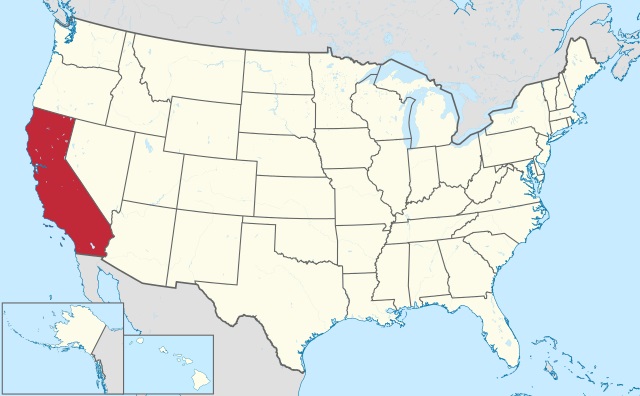
Main Californian Grapes
| Variety | Acres |
|---|---|
| Cabernet Sauvignon | 95,000 |
| Chardonnay | 90,000 |
| Pinot Noir | 46,000 |
| Zinfandel | 38,000 |
| Merlot | 34,000 |
| French Colombard | 16,500 |
| Pinot Gris | 16,500 |
| Sauvignon Blanc | 15,500 |
| Syrah | 14,500 |
| Total | 590,000 |
Source: www.nass.usda.gov April 2022.
Cabernet Sauvignon
Cabernet Sauvignon and Cabernet blends from California rank among the most exclusive and expensive wines in USA.
The largest acreage is in Napa, San Luis Obispo, Sonoma and San Joaquin.
Recommendations: Napa Valley (Oakville, Stags Leap, Rutherford)
Chardonnay
Chardonnay is California’s most-planted white winegrape, and the most popular wine in USA for the last decade.
The largest acreage is in Monterey, Sonoma and San Joaquin.
Recommendations: Sonoma (Russian River), Monterey (Santa Lucia Highlands)
Pinot Noir
Pinot Noir has been steadily growing in popularity after the movie "Sideways" helped propel the sales.
The largest acreage is in Sonoma, Monterey and Santa Barbara.
Recommendations: Sonoma (Russian River, Sonoma Coast), Santa Barbara (Sta. Rita Hills)
Zinfandel
Zinfandel arrived in the United States around 1830, and to California during the gold rush in 1850. It is one of the most important varieties in the USA, and nearly all Zinfandel wines come from California, including the very special white Zinfandel.
The largest acreage is in San Joaquin and Sonoma.
Recommendations: Lodi, Dry Creek Valley, Amador County
Merlot
Merlot from California is one of the most popular table wines sold in US food stores.
The largest acreage is in San Joaquin, Napa and Sonoma.
Syrah & Rhône Blends
Recommendations: Paso Robles, Ballard Canyon, El Dorado
Main Californian Wine Regions
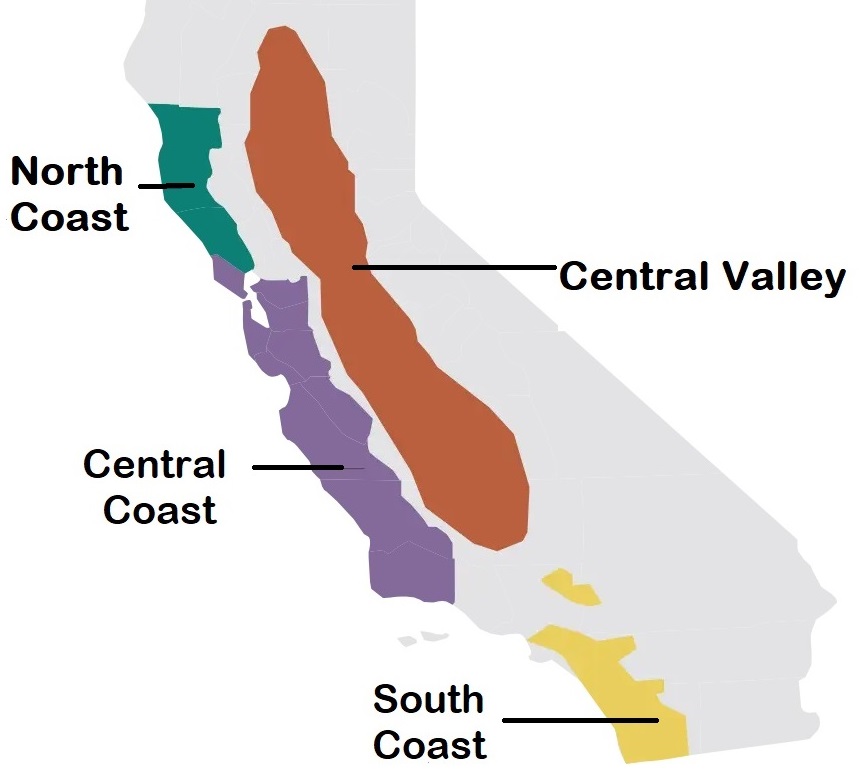
| Region | Notable AVAs |
|---|---|
| Nort Coast AVA | Napa Valley Sonoma Country Mendicio Country Lake Country |
| Central Coast | Santa Cruz Mountains Monterey County San Luis Obispo County Santa Barbara County |
| Central Valley | Lodi Clarksburg |
| South Coast | Los Angeles Temecula Valley Sand Diego Country |
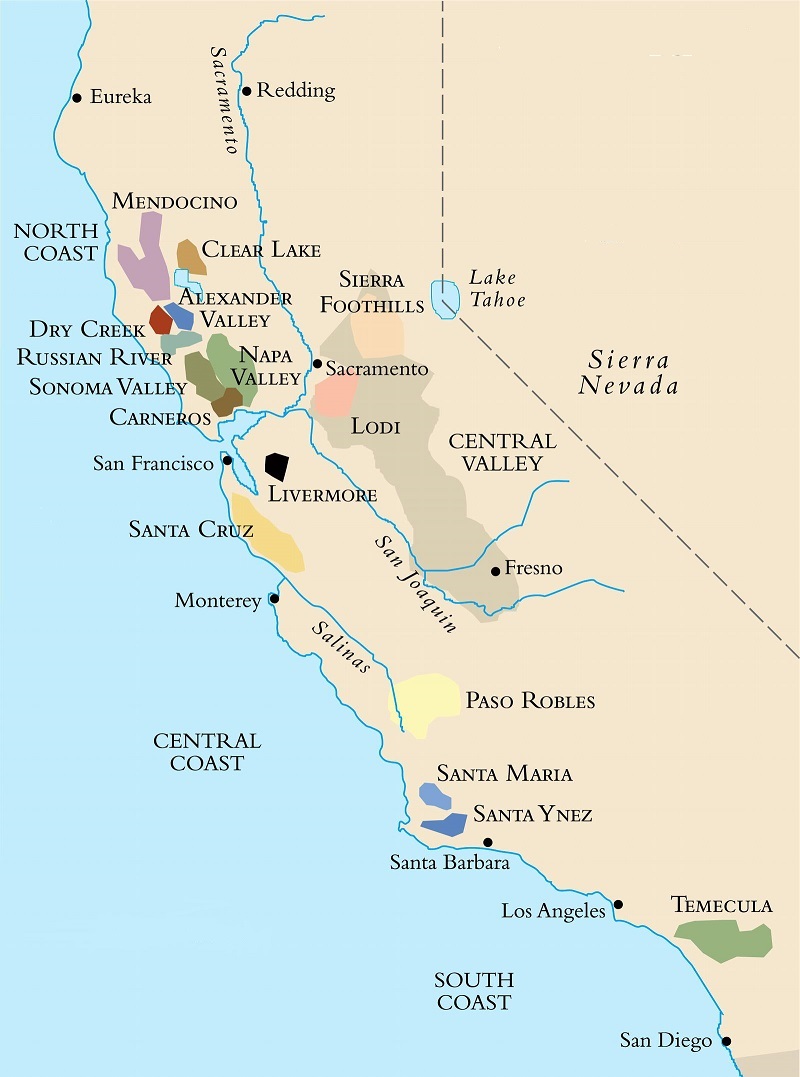
NORTH COAST AVA
The North Coast is California’s most prestigious wine region.
It comprises the vineyards north of San Francisco.
The AVAs here are known for premium Cabernet Sauvignon, Pinot Noir, and Chardonnay.
The most famous are:
| AVA | Main Grapes |
|---|---|
| Napa Valley | Cabernet Sauvignon |
| Sonoma Country | Pinot Noir, Chardonnay, Zinfandel |
| Mendocino County | Cool-climate whites, Pinot Noir |
| Lake County | Affordable, high-altitude wines |
Napa Valley AVA
Napa Valley is one of the most renowned wine regions, not just in the USA, but also world wide. Located in Northern California, it is known for its world-class Cabernet Sauvignon wines.
Notable Sub AVAs
- Howell Mountain (High-elevation bold reds)
- Calistoga (Full-bodied warm-climate Cabernets)
- St. Helena (Full-bodied warm-climate Cabernets)
- Rutherford (famous for "Rutherford Dust" Cabernet)
- Oakville (Exceptional Napa Valley Cabernet Sauvignon)
- Stags Leap District (Elegant Cabernets)
- Coombsville (Cool-climate Bordeaux blends)
- Los Carneos (Cool-climate Pinot Noir, Chardonnay, Sparkling)
Sonoma County AVA
Sonoma is a renowned wine region in California known for its diverse and high-quality wines. The region produces a wide range of varietals, including Chardonnay, Pinot Noir, Zinfandel, and Cabernet Sauvignon.
Notable Sub AVAs
- Russian River Valley (Cool-climate Pinot Noir & Chardonnay)
- Alexander Valley (Lush Cabernet Sauvignon)
- Dry Creek Valley (High-quality Zinfandel)
- Sonoma Valley (Elegant, fog-influenced Pinot Noir)
- Sonoma Mountain (Powerful, yet elegant Cabernet Sauvignon)
- Sonoma Coast
Mendocino County AVA
Medocino County is the northernmost AVA on the Nort Coast.
It is most famous for its cool-climate whites and Pinot Noir.
Notable Sub AVAs
- Anderson Valley (Excellent sparkling wine, Riesling, Pinot Noir)
- Redwood Valley (Old-vine Zinfandel & Petite Sirah)
Lake County (AVA 1981)
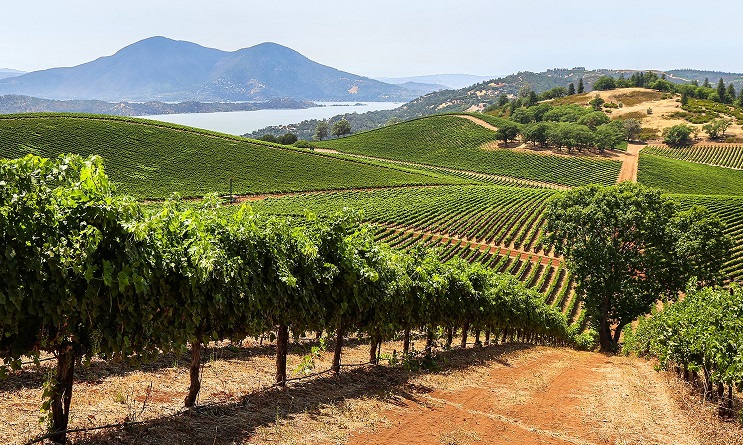
Clear Lake and Mount Knoocti are just part of the breathtaking Lake County AVA in California. Photo by Nathan DeHart.
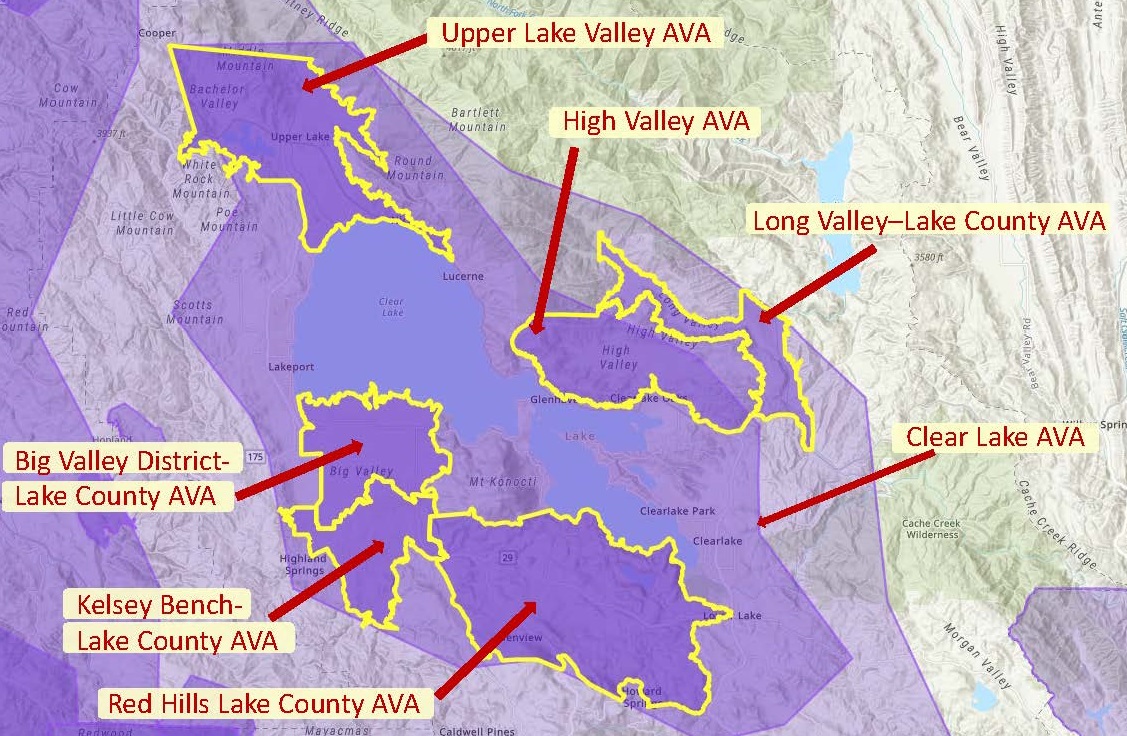
Base map via the TTB AVA Explorer
Lake Country is located north of Napa and east of Medocino Country.
It is most famous for affordable, high-altitude wines. and enjoys a reputation for bright, red wines made from Cabernet Sauvignon, Syrah and Zinfandel, and fresh, aromatic whites made from Sauvignon blanc.
Clear Lake (AVA 1984)
The Clear Lake wine district includes the Big Valley District AVA, the High Valley AVA, the Kelsey Bench AVA, and the Red Hills AVA.
Red Hills Lake County (AVA 2004)
The Red Hills wine region is located along the southwestern shores of Clear Lake, at the foot of Mount Konocti volcano. The terrain is rolling hills with elevations between 1,400 feet (430 m) and 3,000 feet (910 m).
Cabernet Sauvignon dominates with 3,250 acres (1,320 ha) under vines.
High Valley Lake County (AVA 2005)
The High Valley wine is located in the eastern part of the Lake County, on high elevations ranging from 1,600 to 3,000 feet (490 to 910 m). Red volcanic soils can be found on the hillsides while alluvial fans and benches on the valley floor provide well-drained beds for the vines.
Red Bordeaux varietals and Syrah can be found planted along the warmer ridges, while the cooler valley floor contains Pinot gris, Pinot noir, Chardonnay, Riesling and Sauvignon blanc.
Lake County Grapes
| Grape | Acres |
|---|---|
| Cabernet Sauvignon | 5,675 |
| Sauvignon Blanc | 2,406 |
| Petite Sirah | 702 |
| Chardonnay | 512 |
| Zinfandel | 370 |
| Syrah | 312 |
| Merlot | 302 |
| Pinot Gris | 233 |
| California Department of Food and Agriculture 2023 | |
CENTRAL COAST
Stretching from San Francisco Bay to Santa Barbara, the central coast area benefits from Pacific Ocean cooling, ideal for Chardonnay, Pinot Noir, and Rhône varietals.
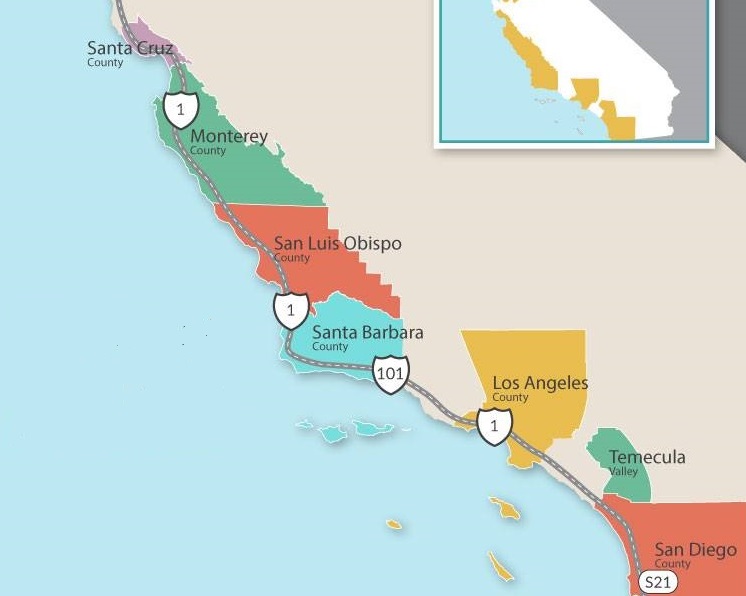
Santa Cruz Mountains AVA
Santa Cruz Mountains was one of the first AVAs (1982) to be defined by its topography.
Based on elevation, the AVA follows the fog line along the coast, down to 800 feet (240 m) on the eastern slope toward San Francisco Bay, 400 feet (120 m) on the western slope to the Pacific Ocean and extending along the ridge crest line at 3,000 feet (910 m).
Very elegant Cabernet Sauvignons are produced in this moderate climate as well as high quality Pinot Noir and Chardonnay.
Varieties
- Cabernet Sauvignon (25%)
- Pinot Noir (25%)
- Chardonnay (25%)
- Merlot (10%)
- Zinfandel (8%)
Monterey County AVAs
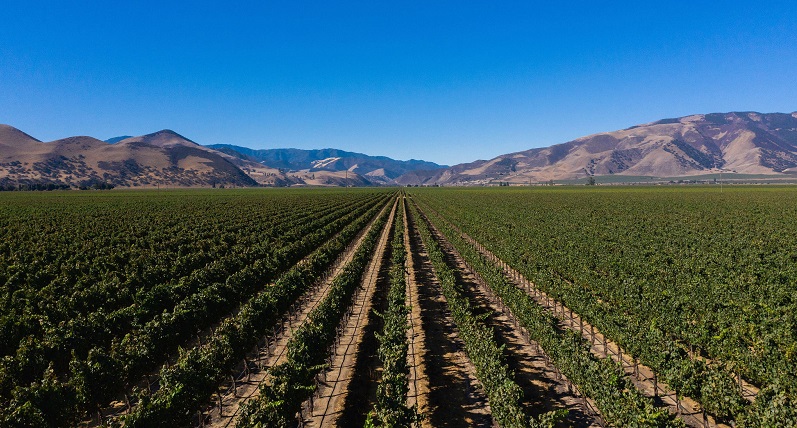
Arroyo Seco AVA, Monterey County, California.
Notable AVAs
- Santa Lucia Highlands (Top-tier Pinot Noir & Chardonnay)
- Arroyo Seco (High-acidity whites like Riesling)
Varieties
- Cabernet Sauvignon
- Merlot
- Pinot Noir
- Syrah
- Chardonnay
- Riesling
San Luis Obispo County AVAs
The Pacific Ocean provides a Mediterranean climate with long and sunny growing seasons.
The vineyards close to the ocean, or at altitude, are cool enough for excellent Chardonnay, Pinot Noir, and sparkling wines.
Vineyards in the inland, isolated by mountains, are warm enough to ripen robust red varieties.
Notable AVAs
- Paso Robles (Cabernet Sauvignon, Merlot, Rhône blends like Syrah, Grenache)
- Edna Valley (Chardonnay, cool-climate Pinot Noir)
Varieties
- Cabernet Sauvignon (47%)
- Merlot (8%)
- Chardonnay (7%)
- Pinot Noir (5%)
- Syrah (6%)
Santa Barbara County AVAs
Notable AVAs
- Sta. Rita Hills (Elegant, Burgundian-style Pinot Noir)
- Santa Maria Valley (Quality cool-climate Pinot & Chardonnay)
- Ballard Canyon (Highly regarded Syrah)
Varieties
- Pinot Noir (2,250 ha)
- Chardonnay (1,700 ha)
- Syrah (500 ha)
- Sauvignon Blanc (300 ha)
- Cabernet Sauvignon (200 ha)
South Coast AVAs

Los Angeles AVAs
- Malibu Coast (Chardonnay)
- Saddle Rock Malibu (Cabernet Sauvignon)
- Malibu-Newton Canyon (Cabernet Sauvignon)
Temecula Valley AVA
The Temecula Valley AVA is located at the border of San Diego County.
It is Southern California’s largest wine producing region by volume, producing a variety of wines, including Syrah, Cabernet Sauvignon, Zinfandel, Chardonnay, and Pinot Noir.
Sand Diego Country AVAs
- San Pasqual Valley (Sangiovese, Merlot, Pinot Noir)
- Ramona Valley (Zinfandel, Grenache, Sangiovese)
Sierra Foothills AVAs
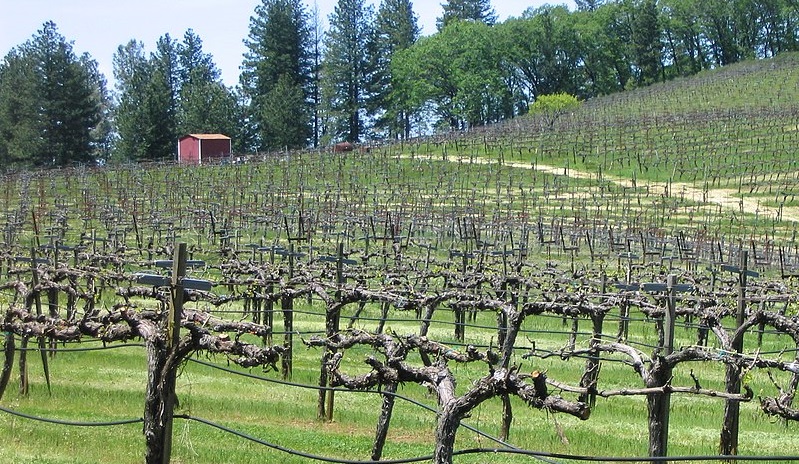
Known for bold, old-vine Zinfandel, these AVAs have a rich history dating back to the Gold Rush:
- El Dorado (Zinfandel, Barbera, Syrah)
- Amador County (Old-vine Zinfandel)
- Fiddletown (robust Rhône-style wines)
Central Valley AVAs
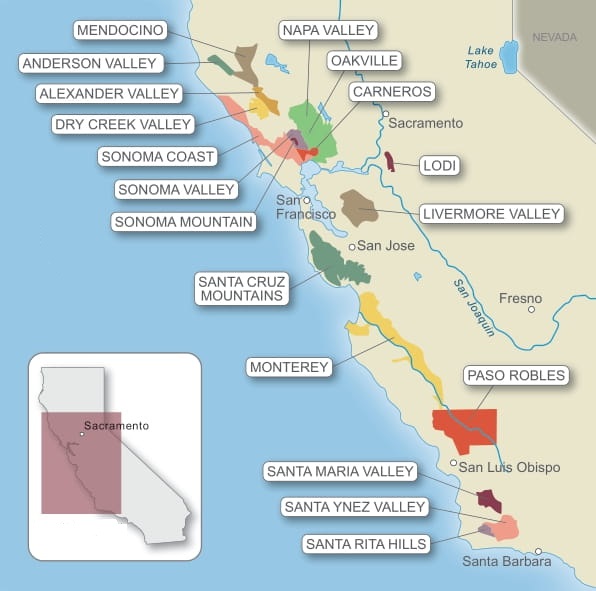
Central Valley is a powerhouse for affordable wines, best known for Zinfandel and Chardonnay.
Notable AVAs
- Lodi (top-tier Old Vine Zinfandel)
- Clarksburg (aromatic whites: Chenin Blanc, Albariño)